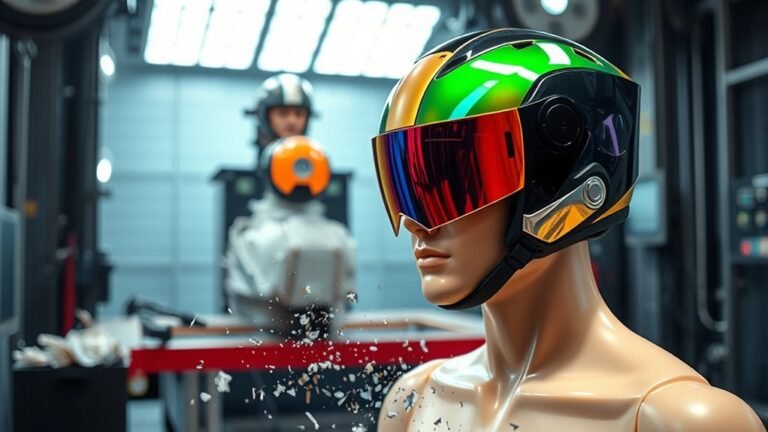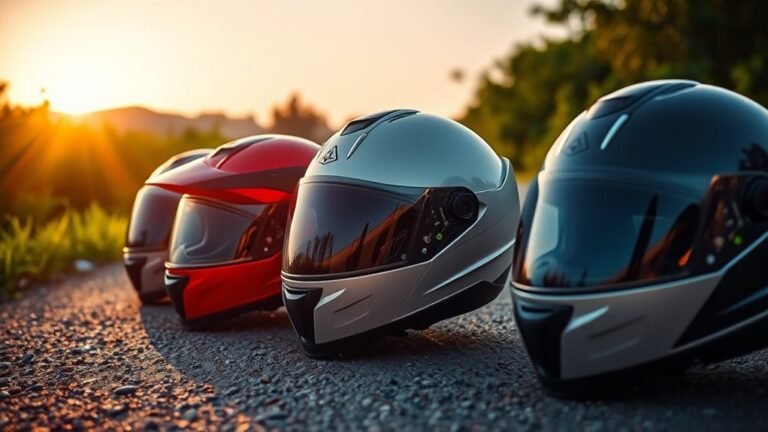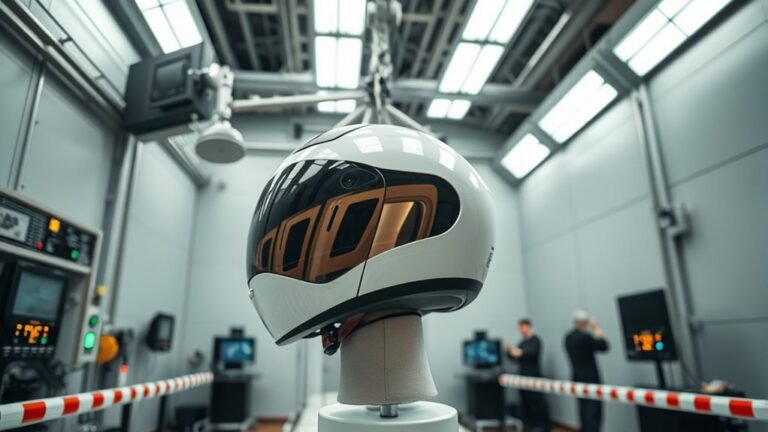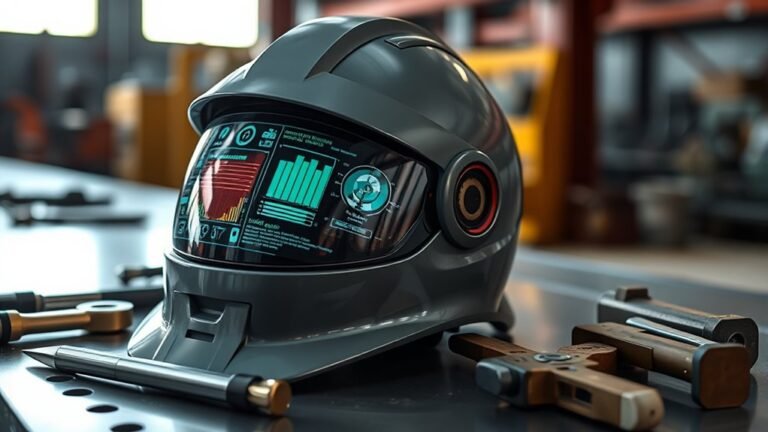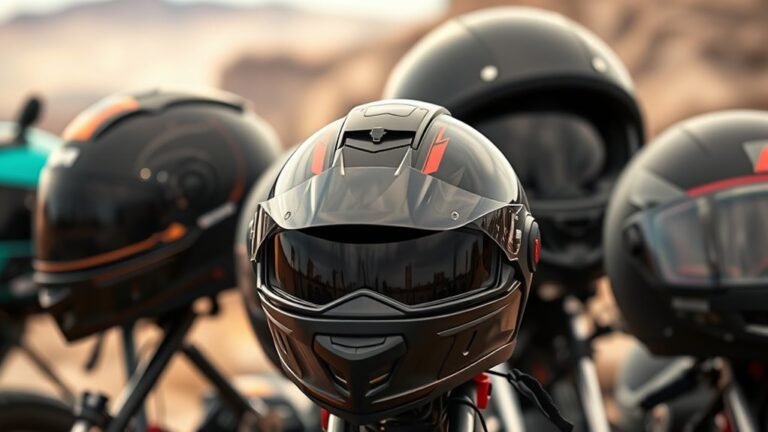Difference Between Type I and Type II Hard Hats
Type I and Type II hard hats serve different safety purposes. Type I hard hats focus on top impact protection, making them ideal for construction and industrial environments with overhead hazards. In contrast, Type II hard hats provide both top and lateral impact protection, suitable for more diverse and hazardous job sites. While Type II helmets are generally heavier and costlier, they offer enhanced safety features. If you’re interested in understanding more about their features and best use, keep exploring.
Overview of Hard Hat Types
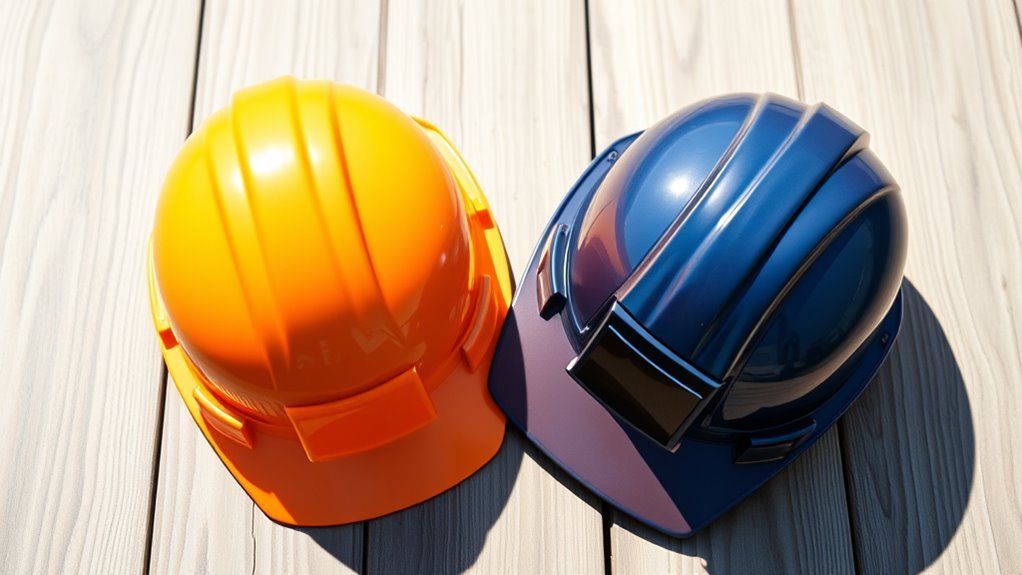
When considering safety gear for construction and industrial environments, understanding the differences between hard hat types is fundamental. Hard hats are primarily categorized into two types based on their design and intended protection—Type I and Type II. Type I hard hats are designed to protect against impacts to the top of the head, while Type II hard hats offer protection from lateral impacts as well. The materials used in hard hats, such as high-density polyethylene (HDPE) or fiberglass, play a significant role in their protective capabilities and durability. Compliance with safety regulations, such as those set by the American National Standards Institute (ANSI), is essential to guarantee that the hard hats you choose meet the necessary safety standards for your specific work environment.
Understanding Type I Hard Hats
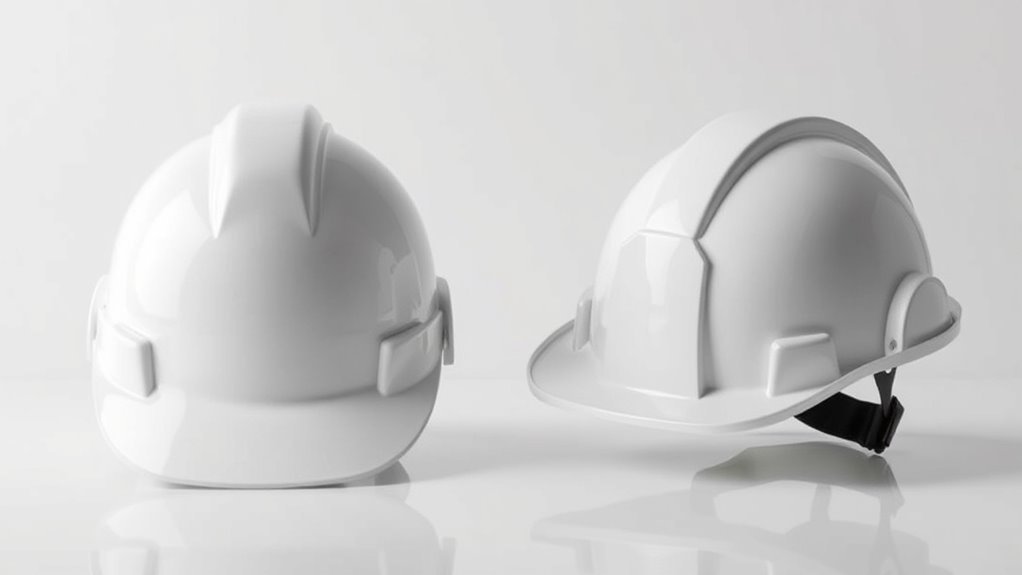
Type I hard hats are designed primarily for top-impact protection, featuring a streamlined structure that guarantees safety without compromising comfort. They meet specific protection standards set by regulatory bodies, making them suitable for various work environments. You’ll find these hard hats commonly used in construction and industrial settings where overhead hazards are present.
Design and Structure
Hard hats are essential for ensuring safety in various work environments, and understanding the design and structure of Type I hard hats is fundamental for proper usage. Type I hard hats are typically made from durable hard hat materials like high-density polyethylene (HDPE) or fiberglass, providing adequate protection against impact from falling objects. The structural differences between Type I and Type II hard hats lie primarily in their design; Type I hard hats are designed to protect against top impacts only, making them ideal for construction sites. Their inner suspension system is critical for absorbing shock and ensuring a secure fit. By familiarizing yourself with these elements, you can choose the right hard hat and enhance your safety on the job.
Protection Standards
While understanding the protection standards for hard hats is essential for workplace safety, it’s particularly important to recognize the specific requirements that govern Type I hard hats. These hard hats are designed to protect against vertical impacts and are compliant with the American National Standards Institute (ANSI) Z89.1 safety standards. They must pass rigorous testing to guarantee they meet the necessary protection regulations for impact resistance. When selecting a Type I hard hat, you’re ensuring that it can withstand falling objects and provide adequate safety for workers in environments like construction sites. Familiarizing yourself with these standards helps you make informed choices, ultimately contributing to a safer work environment and reducing the risk of head injuries.
Usage Scenarios
When working in environments where falling objects are a risk, understanding the usage scenarios for Type I hard hats becomes vital. These hard hats are specifically designed for use in construction sites and industrial environments where overhead hazards are prevalent. When you’re involved in tasks like demolition, roofing, or heavy material handling, wearing a Type I hard hat offers protection from impacts originating from above. It’s important to guarantee the hard hat fits properly and meets the required safety standards. While Type I hard hats focus on vertical impact protection, they may not provide lateral protection. As a result, assess your work environment thoroughly to determine if a Type I hard hat is suitable for your specific needs. Safety should always be your top priority.
Key Features of Type I Hard Hats
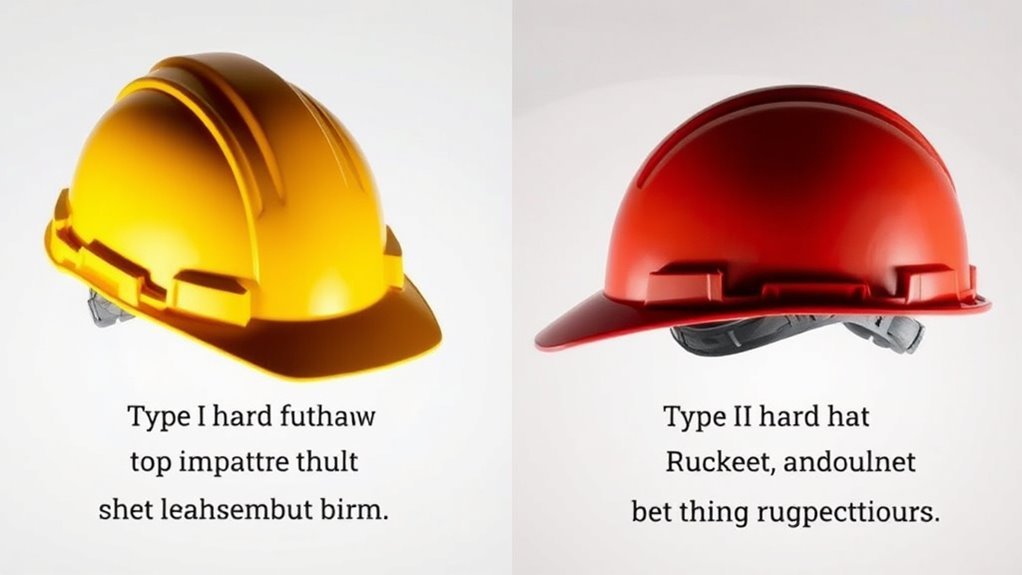
Type I hard hats are specifically designed for top impact protection, making them essential in various industrial environments. They focus on shielding your head from falling objects and lateral impacts. These hard hats are constructed from durable hard hat materials, guaranteeing high impact resistance and longevity. Here are some key features to take into account:
- Top impact protection: Protects against falling objects from above.
- Lightweight design: Assures comfort during extended wear.
- Adjustable suspension system: Allows for a secure and customized fit.
- Ventilation options: Enhances airflow for comfort in hot conditions.
- Variety of colors: Facilitates identification and compliance with safety codes.
Choosing the right Type I hard hat can greatly enhance your safety and performance on the job site.
Understanding Type II Hard Hats
Understanding the nuances of Type II hard hats is essential for guaranteeing thorough head protection in diverse work environments. These hard hats are designed to protect against impacts from above and lateral forces, making them suitable for various job sites.
| Type II Benefits | Type II Limitations |
|---|---|
| Improved lateral impact protection | Generally heavier than Type I |
| Versatile for different tasks | May not be necessary for all jobs |
| Enhanced comfort features | Higher cost compared to Type I |
Choosing a Type II hard hat can considerably enhance safety, especially in construction and industrial settings. However, it’s important to weigh the benefits against the limitations to guarantee you’re selecting the right headgear for your specific needs.
Key Features of Type II Hard Hats
Hard hats classified as Type II come equipped with several key features that enhance their protective capabilities. These features guarantee you’re well-protected in various environments, particularly from lateral impacts and electrical hazards. Here’s what you can expect from a Type II Hard Hat:
- Enhanced Side Protection: Offers additional defense against lateral impacts.
- Adjustable Suspension Systems: Guarantees a snug fit for comfort and stability.
- Electrical Insulation: Provides protection against electrical hazards up to a certain voltage.
- Durable Materials: Made from robust materials designed to withstand harsh conditions.
- Ventilation Options: Features ventilation to keep you cool during extended wear.
With these features, a Type II Hard Hat is an essential component of your safety gear, allowing you to work confidently and efficiently.
Comparing Protection Levels
When evaluating safety gear, it’s important to recognize the differences in protection levels offered by various hard hat classifications. Type I hard hats are designed primarily for vertical impact protection, making them suitable for environments where objects fall from above. In contrast, Type II hard hats provide additional lateral protection, adhering to stricter industry standards. This means they’re better suited for situations where side impacts are a concern. Understanding these protection levels is vital for selecting the right hard hat, ensuring you remain safe in diverse work environments. It’s critical to choose a hard hat that meets the specific demands of your job, as this can greatly reduce the risk of head injuries caused by falling or flying objects.
Choosing the Right Hard Hat for Your Industry
How can you guarantee your hard hat meets the specific requirements of your industry? To ascertain compliance with hard hat regulations, consider these essential factors:
- Industry Standards: Research the specific hard hat regulations applicable to your field.
- Type Selection: Choose between Type I and Type II based on your work environment.
- Comfort and Fit: Confirm the hard hat fits securely for maximum protection and comfort.
- Additional Features: Look for features like ventilation, adjustable straps, or face shields if needed.
- Certification: Verify that your hard hat has been certified by a recognized testing agency.
Maintenance and Care for Hard Hats
To guarantee your hard hat remains effective, regular cleaning and proper inspection are essential. You’ll need to assess its condition regularly and replace it according to manufacturer guidelines or if you notice any signs of wear. This proactive approach helps maintain safety standards and extends the lifespan of your head protection.
Regular Cleaning Practices
Regular maintenance of hard hats is essential for ensuring their effectiveness and longevity. To keep your hard hat in prime condition, establish a regular cleaning frequency based on usage. Here are some recommended cleaning methods:
- Use mild soap and water for basic cleaning.
- Rinse thoroughly to remove any soap residue.
- Avoid harsh chemicals or solvents that can damage materials.
- Dry with a soft cloth and avoid direct sunlight.
- Inspect the suspension system and shell for wear during cleaning.
Inspection and Replacement Timing
Inspecting your hard hat regularly is essential for maintaining safety standards on the job. Establishing an inspection frequency helps guarantee your hard hat remains effective. It’s recommended to check your hard hat before each use and conduct a more thorough inspection monthly. Follow replacement guidelines to determine when to retire your hard hat; typically, replace it every 2-5 years or sooner if damage occurs.
Here’s a quick reference table for inspection and replacement timing:
| Inspection Frequency | Signs of Damage | Recommended Replacement Timing |
|---|---|---|
| Before each use | Cracks, dents, or wear | Every 2-5 years |
| Monthly | Discoloration or fading | If exposed to extreme conditions |
| After incidents | Any visible damage | Immediately |
| Manufacturer’s advice | Non-compliance with standards | As directed by the manufacturer |
Frequently Asked Questions
Are Type I and Type II Hard Hats Interchangeable?
No, Type I and Type II hard hats aren’t interchangeable due to differences in design and safety standards. Type I hard hats are primarily for vertical impacts, while Type II provides protection from both vertical and lateral impacts. Ensuring hard hat compatibility is essential for your safety in various work environments. Always choose the appropriate type based on the specific hazards you’ll face, as adhering to safety standards can greatly reduce your risk of injury.
What Is the Weight Difference Between Type I and Type II Hard Hats?
When you compare the weight of Type I and Type II hard hats, you might think they’re featherweights, but it’s not that simple! Generally, Type I hats are a tad lighter due to their material differences, often using high-density polyethylene. Type II hats, designed for more versatility, can weigh slightly more because of added features for lateral impact protection. So, while the difference isn’t massive, every ounce counts in your quest for comfort and freedom on the job!
Can Hard Hats Be Customized With Logos or Designs?
Yes, hard hats can be customized with logos or designs, offering various customization options. When considering branding, it’s important to choose materials and techniques that maintain the hard hat’s safety standards. Screen printing, decals, and stickers are common methods used for branding considerations. However, verify that the customization doesn’t interfere with the hard hat’s structural integrity or compliance with safety regulations. Personalizing your hard hat can enhance team identity while promoting safety awareness.
What Is the Lifespan of a Hard Hat?
A hard hat typically lasts about 3 to 5 years, but it can vary based on the materials used and exposure to environmental factors. If you think of it as a knight’s helmet in a battle, it’s vital to replace it when it shows signs of wear or damage. Adhering to safety standards guarantees that you’re protected; don’t overlook the importance of regular inspections to maintain your safety on the job.
Are There Specific Regulations for Hard Hat Use in Different Countries?
Yes, there are specific hard hat regulations that vary by country. You’ll find that international standards, like those from ISO or ANSI, guide these regulations. In the U.S., OSHA mandates certain requirements for hard hat use, while European countries may follow EN standards. It’s crucial to familiarize yourself with the local regulations wherever you are working to guarantee compliance and safety. Always prioritize your protection by adhering to the applicable standards.

